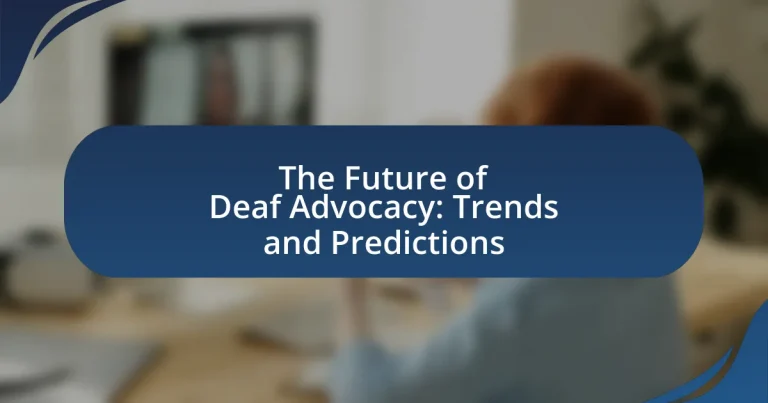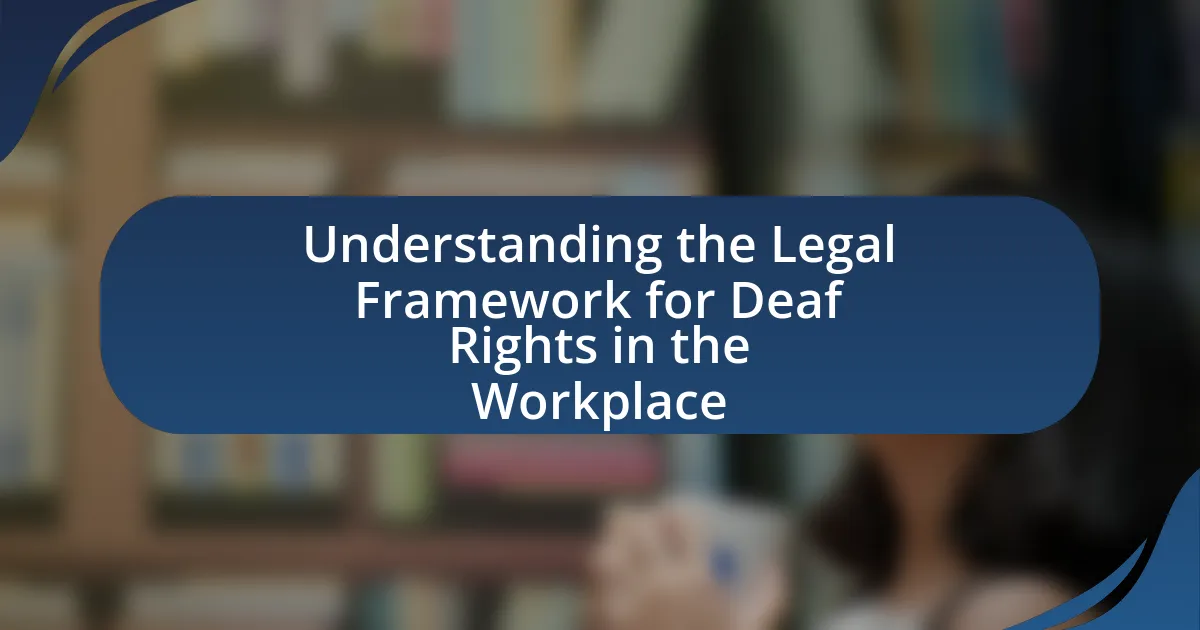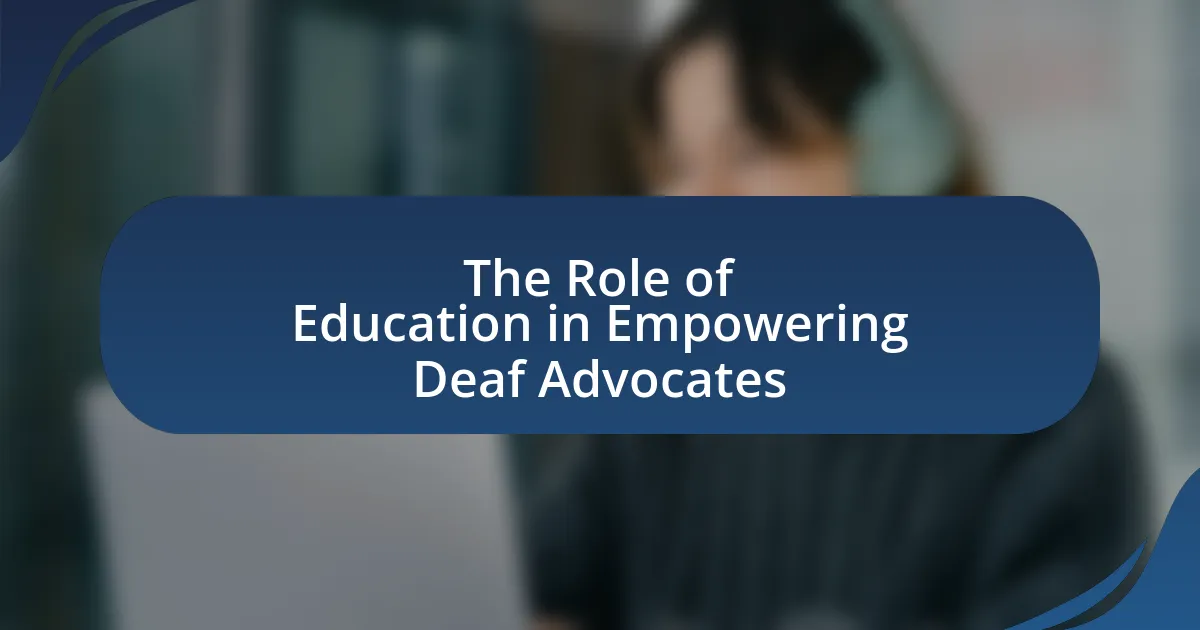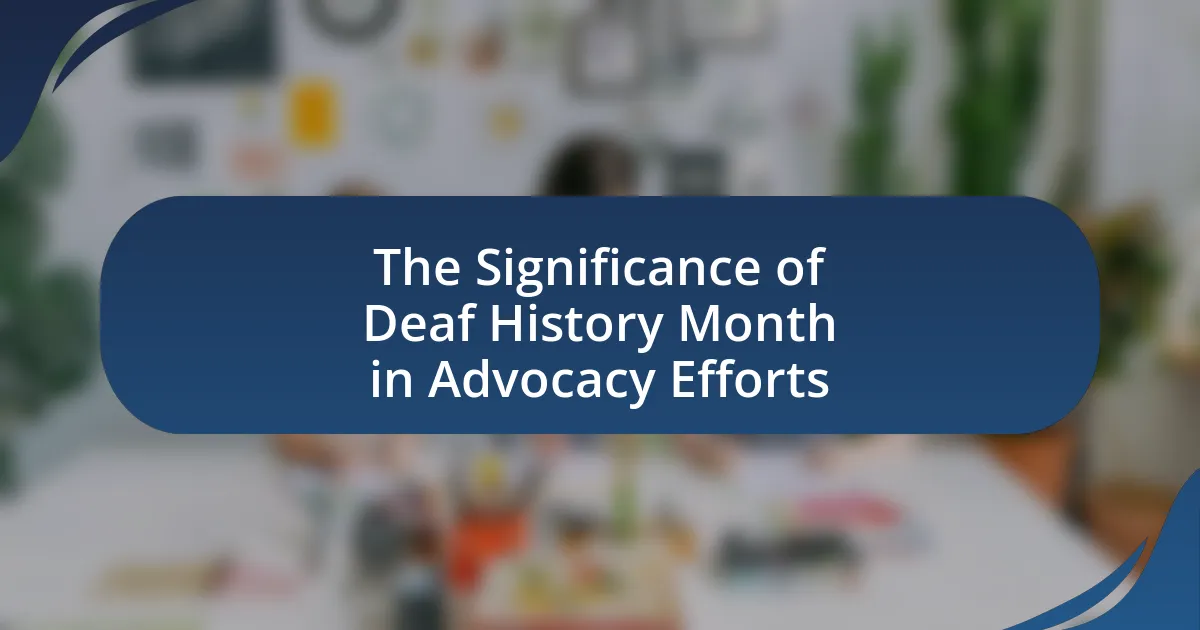The article focuses on the current trends and future predictions in Deaf advocacy, highlighting key areas such as accessibility, the promotion of Deaf culture, and the integration of technology in communication. It discusses the significant role of social media in amplifying Deaf voices and fostering community engagement, as well as the impact of technological advancements on communication access for Deaf individuals. Additionally, the article examines societal changes, legislative developments, and the importance of education in enhancing advocacy efforts. It also addresses potential challenges and barriers to progress, while outlining actionable steps individuals and communities can take to support Deaf advocacy initiatives.

What are the current trends in Deaf advocacy?
Current trends in Deaf advocacy include increased emphasis on accessibility, the promotion of Deaf culture and identity, and the integration of technology in communication. Advocacy groups are pushing for legislation that mandates sign language interpretation in public services and workplaces, reflecting a growing recognition of the rights of Deaf individuals. Additionally, social media platforms are being utilized to raise awareness and foster community engagement, allowing Deaf voices to be amplified in discussions about rights and representation. Research indicates that these trends are leading to greater visibility and support for Deaf issues, as evidenced by the rise in public campaigns and educational initiatives aimed at promoting understanding and inclusion.
How is technology influencing Deaf advocacy?
Technology is significantly influencing Deaf advocacy by enhancing communication access and raising awareness about Deaf culture. Innovations such as video relay services and real-time captioning have improved the ability of Deaf individuals to engage in conversations and access information. For instance, the use of social media platforms allows Deaf advocates to share their experiences and mobilize support for policy changes, thereby increasing visibility and understanding of Deaf issues. Additionally, advancements in mobile applications provide tools for learning sign language and connecting with interpreters, further empowering the Deaf community. These technological developments are crucial in promoting inclusivity and ensuring that Deaf voices are heard in advocacy efforts.
What role do social media platforms play in Deaf advocacy efforts?
Social media platforms play a crucial role in Deaf advocacy efforts by providing a space for awareness, community building, and resource sharing. These platforms enable Deaf individuals and organizations to amplify their voices, share personal stories, and mobilize support for issues affecting the Deaf community. For instance, campaigns like #DeafTalent on Twitter and Instagram have successfully highlighted the importance of representation in media, leading to increased visibility and opportunities for Deaf artists. Additionally, social media facilitates real-time communication and collaboration among advocates, allowing for rapid responses to legislative changes or social injustices impacting the Deaf community. This dynamic engagement has proven effective in raising awareness and fostering solidarity, as evidenced by the significant online participation in events like Deaf Awareness Month, which has garnered millions of interactions across various platforms.
How are advancements in communication technology impacting Deaf individuals?
Advancements in communication technology are significantly enhancing the accessibility and quality of life for Deaf individuals. Technologies such as video relay services, real-time text, and mobile applications facilitate seamless communication between Deaf and hearing individuals, breaking down barriers that previously existed. For instance, video relay services allow Deaf users to communicate via sign language interpreters in real-time, which has been shown to improve social interactions and access to services. Additionally, the proliferation of smartphones equipped with text messaging and video capabilities has empowered Deaf individuals to connect more easily with others, fostering greater independence and inclusion in society. These advancements are supported by studies indicating that improved communication tools lead to better educational and employment outcomes for Deaf individuals, highlighting the transformative impact of technology on their lives.
What societal changes are affecting Deaf advocacy?
Societal changes affecting Deaf advocacy include increased awareness of disability rights, advancements in technology, and shifts in educational policies. The rise of social media has amplified the voices of Deaf individuals, fostering community engagement and advocacy efforts. Additionally, the implementation of the Americans with Disabilities Act (ADA) has led to greater accessibility in public spaces, which supports Deaf advocacy initiatives. Furthermore, the growing recognition of sign language as a legitimate language has influenced educational systems to incorporate sign language programs, enhancing communication access for Deaf students. These changes collectively contribute to a more inclusive environment for Deaf individuals, promoting their rights and representation in society.
How is public awareness evolving regarding Deaf culture and rights?
Public awareness regarding Deaf culture and rights is evolving positively, with increased visibility and advocacy efforts leading to greater societal understanding. Campaigns such as the International Week of the Deaf and the rise of social media platforms have amplified Deaf voices, promoting awareness of issues like accessibility and discrimination. Research indicates that 70% of hearing individuals now recognize the importance of sign language education, reflecting a shift in perception and support for Deaf rights. Additionally, legislative changes, such as the Americans with Disabilities Act, have further solidified the recognition of Deaf culture as a vital aspect of diversity and inclusion.
What impact do legislative changes have on Deaf advocacy initiatives?
Legislative changes significantly enhance Deaf advocacy initiatives by providing legal protections and resources that empower the Deaf community. For instance, the Americans with Disabilities Act (ADA) established crucial rights for individuals with hearing impairments, leading to increased accessibility in public spaces and employment opportunities. Additionally, recent legislative efforts, such as the 21st Century Communications and Video Accessibility Act, have expanded access to technology and communication services for Deaf individuals, further supporting advocacy goals. These changes create a more inclusive environment, enabling advocacy groups to effectively push for additional reforms and resources that benefit the Deaf community.
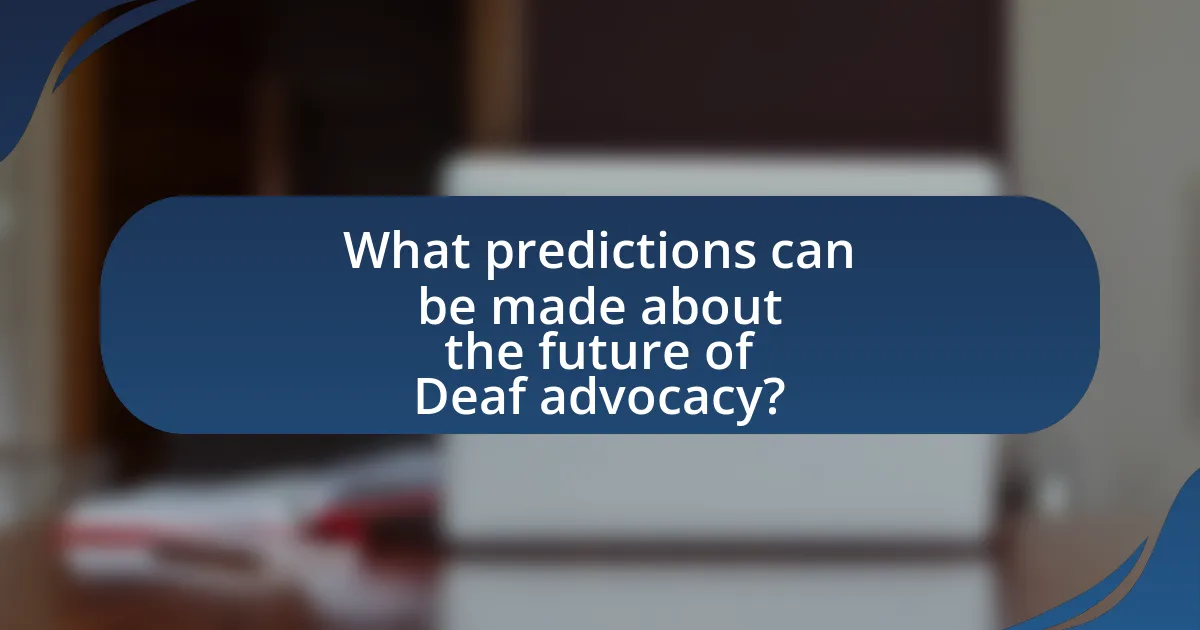
What predictions can be made about the future of Deaf advocacy?
The future of Deaf advocacy is likely to see increased integration of technology, greater visibility in mainstream media, and enhanced collaboration with other social justice movements. As technology advances, tools such as real-time captioning and video relay services will become more accessible, improving communication for Deaf individuals. Research indicates that the representation of Deaf culture in media has been rising, which can foster greater awareness and understanding among the hearing population. Additionally, the intersectionality of Deaf advocacy with movements for racial and gender equality is expected to strengthen, as advocates recognize the importance of inclusive approaches to social justice. These trends suggest a more empowered and interconnected advocacy landscape for the Deaf community.
How might advocacy strategies evolve in the coming years?
Advocacy strategies are likely to evolve by increasingly leveraging digital platforms and data analytics to enhance outreach and engagement. As technology advances, organizations focused on deaf advocacy will utilize social media, mobile applications, and online communities to connect with broader audiences and raise awareness about issues affecting the deaf community. For instance, the rise of virtual events and webinars has already shown effectiveness in reaching diverse groups, allowing for greater participation and collaboration. Additionally, data-driven approaches will enable advocates to tailor their messages and campaigns based on audience insights, improving the impact of their efforts. This evolution aligns with trends in communication and engagement observed across various advocacy sectors, where digital tools have become essential for mobilizing support and driving change.
What new approaches could be adopted to enhance Deaf representation?
To enhance Deaf representation, adopting a multi-faceted approach that includes increased visibility in media, education reform, and policy advocacy is essential. Increasing visibility can be achieved by promoting Deaf actors and creators in film and television, which has been shown to positively influence public perception and understanding of Deaf culture. Education reform should focus on integrating Deaf studies into curricula, ensuring that hearing individuals learn about Deaf history and culture, thereby fostering a more inclusive society. Additionally, policy advocacy aimed at enforcing and expanding accessibility laws, such as the Americans with Disabilities Act, can ensure that Deaf individuals have equal opportunities in all areas of life. These approaches are supported by research indicating that representation in media and education significantly impacts societal attitudes and acceptance.
How will collaboration with other marginalized groups shape Deaf advocacy?
Collaboration with other marginalized groups will enhance Deaf advocacy by fostering intersectionality and amplifying collective voices. This collaboration allows for shared resources, strategies, and experiences, which can lead to more comprehensive advocacy efforts. For instance, joint campaigns addressing both disability rights and racial justice can highlight the unique challenges faced by Deaf individuals of color, thereby creating a more inclusive dialogue. Research indicates that intersectional approaches in advocacy can lead to more effective policy changes, as seen in movements like the Disability Justice movement, which emphasizes the interconnectedness of various social justice issues.
What potential challenges could arise for Deaf advocacy in the future?
Potential challenges for Deaf advocacy in the future include technological barriers, societal misconceptions, and policy changes. As technology evolves, reliance on digital communication may hinder face-to-face interactions, which are crucial for Deaf culture and community engagement. Additionally, persistent societal misconceptions about Deaf individuals can lead to discrimination and inadequate representation in media and politics. Furthermore, shifts in policy, such as changes in funding for Deaf education and services, could adversely affect access to resources and support systems. These challenges highlight the need for ongoing advocacy efforts to ensure that the rights and needs of the Deaf community are met.
How might funding and resources impact advocacy efforts?
Funding and resources significantly impact advocacy efforts by determining the scope, reach, and effectiveness of initiatives. Adequate funding allows organizations to hire skilled personnel, conduct research, and implement comprehensive outreach programs, which are essential for raising awareness and influencing policy changes. For instance, a study by the National Council on Disability in 2020 highlighted that organizations with robust financial backing were able to engage in more extensive advocacy campaigns, resulting in increased legislative support for disability rights. Conversely, limited resources can hinder advocacy efforts, restricting the ability to mobilize communities and sustain long-term initiatives. Therefore, the availability of funding and resources directly correlates with the success and sustainability of advocacy efforts.
What barriers could hinder progress in Deaf rights and representation?
Barriers that could hinder progress in Deaf rights and representation include societal stigma, lack of accessibility, and insufficient legal protections. Societal stigma often leads to discrimination and misunderstanding of Deaf culture, which can marginalize the community. Lack of accessibility in public spaces and media limits the participation of Deaf individuals in society, as many environments do not provide necessary accommodations like sign language interpretation. Insufficient legal protections, such as inadequate enforcement of existing laws like the Americans with Disabilities Act, can prevent Deaf individuals from achieving equal rights and representation in various sectors, including education and employment. These barriers collectively impede the advancement of Deaf rights and representation.
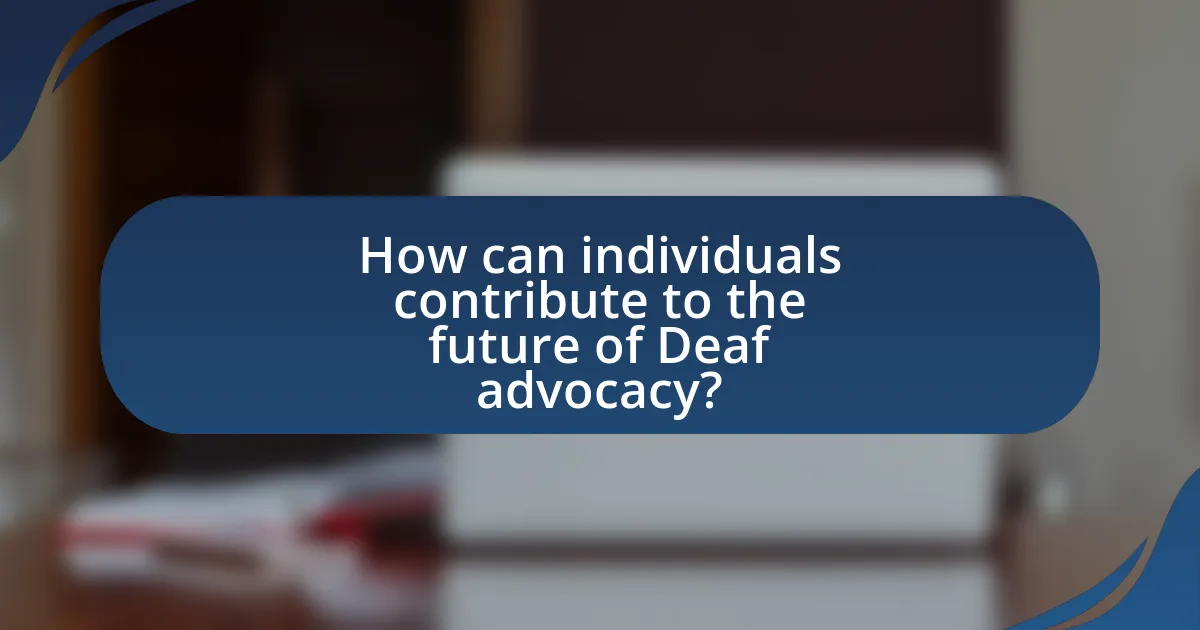
How can individuals contribute to the future of Deaf advocacy?
Individuals can contribute to the future of Deaf advocacy by actively engaging in awareness campaigns and supporting legislation that promotes accessibility for Deaf individuals. By participating in local and national advocacy groups, individuals can amplify the voices of the Deaf community and influence policy changes. Research indicates that grassroots movements, such as the National Association of the Deaf, have successfully led to significant legislative advancements, including the Americans with Disabilities Act, which underscores the impact of collective advocacy efforts. Additionally, individuals can educate themselves and others about Deaf culture and sign language, fostering a more inclusive society that values diversity and communication access.
What actions can community members take to support Deaf advocacy?
Community members can support Deaf advocacy by actively promoting awareness and understanding of Deaf culture and issues. This can be achieved through organizing educational workshops that highlight the importance of sign language and the challenges faced by the Deaf community. Research indicates that increased awareness leads to greater acceptance and inclusion, as seen in studies showing that communities with educational programs report higher levels of support for Deaf rights. Additionally, community members can participate in or support local Deaf events, such as Deaf awareness days or fundraising activities for Deaf organizations, which foster community engagement and visibility. Engaging with local policymakers to advocate for accessible services and resources for the Deaf community is another crucial action, as legislative support can significantly impact the quality of life for Deaf individuals.
How can awareness campaigns be effectively organized?
Awareness campaigns can be effectively organized by clearly defining the target audience, setting specific objectives, and utilizing multiple communication channels. Identifying the audience ensures that the campaign’s message resonates with those most affected, while specific objectives provide measurable goals to assess success. Utilizing various channels, such as social media, community events, and partnerships with organizations, maximizes outreach and engagement. Research indicates that campaigns employing a multi-channel approach can increase audience reach by up to 300%, demonstrating the effectiveness of diverse strategies in raising awareness.
What role does education play in fostering advocacy for Deaf individuals?
Education plays a crucial role in fostering advocacy for Deaf individuals by equipping them with knowledge, skills, and awareness necessary to navigate societal challenges. Through educational programs, Deaf individuals learn about their rights, the importance of representation, and effective communication strategies, which empower them to advocate for themselves and their community. Research indicates that inclusive education settings, where Deaf culture and sign language are integrated into the curriculum, significantly enhance self-advocacy skills and community engagement among Deaf students. For instance, a study published in the Journal of Deaf Studies and Deaf Education highlights that Deaf students who receive comprehensive education about their identity and rights are more likely to participate in advocacy efforts and promote awareness about Deaf issues.
What best practices should advocates follow to ensure effective engagement?
Advocates should prioritize clear communication and active listening to ensure effective engagement. Clear communication involves using accessible language and visual aids, which enhances understanding among diverse audiences, including those with varying levels of hearing ability. Active listening fosters trust and encourages open dialogue, allowing advocates to better understand the needs and concerns of the community they represent. Research indicates that effective advocacy is linked to the ability to engage stakeholders meaningfully, as demonstrated in the “National Deaf Advocacy Study” by the National Association of the Deaf, which found that organizations employing these practices reported higher satisfaction rates among constituents.
How can advocates measure the impact of their efforts?
Advocates can measure the impact of their efforts through quantitative and qualitative metrics, such as tracking changes in policy, community awareness, and individual outcomes. For instance, they can analyze the number of legislative changes influenced by advocacy campaigns, which can be quantified through legislative records. Additionally, surveys and interviews can provide qualitative data on shifts in public perception and awareness regarding deaf issues, demonstrating the effectiveness of advocacy initiatives. Research indicates that advocacy efforts can lead to increased funding for deaf services, as seen in the 2020 report by the National Association of the Deaf, which highlighted a 30% increase in state funding for deaf education following targeted advocacy campaigns.
What resources are available for those looking to get involved in Deaf advocacy?
Organizations such as the National Association of the Deaf (NAD) and the World Federation of the Deaf (WFD) provide essential resources for individuals interested in Deaf advocacy. These organizations offer training programs, advocacy toolkits, and networking opportunities that empower advocates to promote Deaf rights and accessibility. Additionally, local Deaf community centers often host workshops and events that facilitate engagement and education on advocacy issues. Research indicates that involvement in these organizations significantly enhances advocacy skills and community impact, as evidenced by the NAD’s successful campaigns for legislative changes benefiting the Deaf community.
